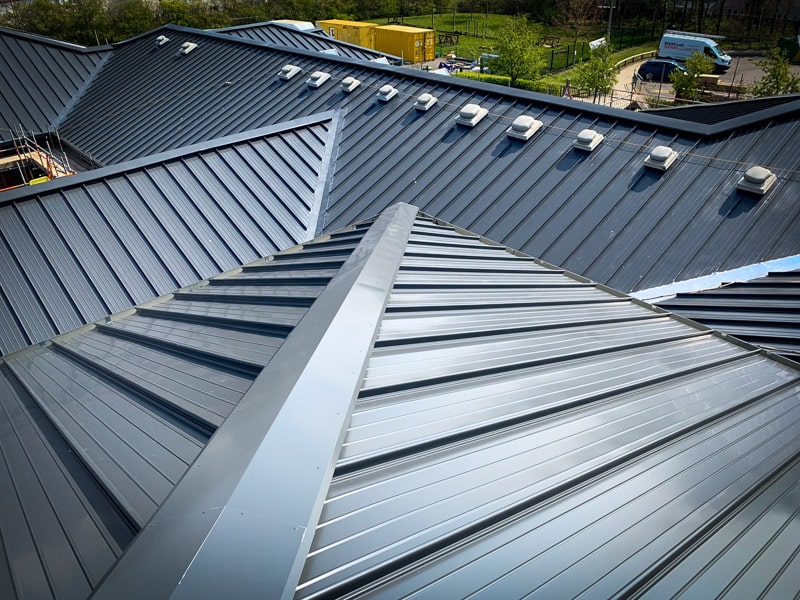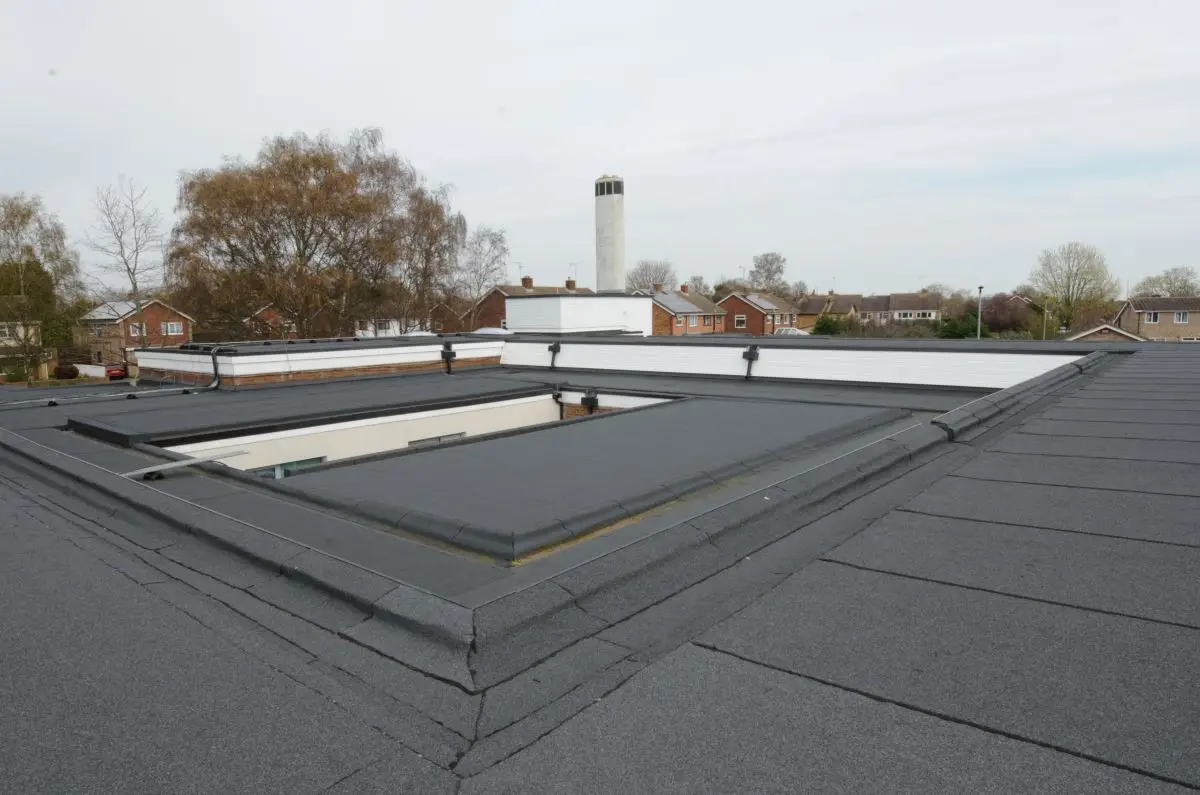

Regular inspections and annual maintenance of a commercial roof should always be essential to asset and facilities management. It helps to preserve the waterproofing membrane, prevent drainage issues and spot any potential problems before they can progress, allowing repairs to be made quickly and cost-effectively. But how do you determine the right time to perform repairs and when it is finally time to replace the roof? This guide will give you the knowledge you need to answer these questions.
Roofing is a substantial investment in your building, so maximising its lifespan ensures you get the best return on investment possible. However, at a certain point, everything, no matter how well looked after, reaches the end of its useable life. Repairs at this point will provide diminishing returns compared to the advantages of a complete roof replacement.
If you have safe access, you can visually inspect your roof to look for any early signs of damage or potential problems before they deteriorate. This allows you to contact your roofing specialist as soon as possible, hopefully well before there is any failure in the waterproofing. From here, they can perform a detailed roofing survey and perform any necessary investigative work to establish the cause of the problem and how best to resolve it.

Understanding the Signs of a Damaged Commercial Roof
The first step is to identify the signs that your roof may be damaged. External signs of damage to your roof can manifest in various ways, such as ponding water, gaps in seams, and deteriorated flashing. Ponding water, for instance, indicates potential issues with the roofing substructure, while gaps in seams can result from natural movements or poor installation. Similarly, deteriorated flashing, often neglected, can lead to leaks due to exposure and damage over time.
Ageing is another factor, as all roofing materials have a limited lifespan. Signs like alligatoring in bitumen membranes can signal that your roof is nearing the end of its cycle. Blistering and organic growth are early indicators of potential problems, requiring immediate attention to prevent further damage. Regular maintenance, including clearing debris from gutters, is crucial to avoid prolonged water retention that can stress the roofing structure over time.
Internally, signs like peeling wallpaper, brown ceiling spots, cracked paint, mould on walls, or internal leaks indicate that external roof issues have already progressed to structural failure. However, promptly noticing these signs can minimise repair costs and prevent further deterioration. Early detection and intervention are crucial to maintaining the integrity of your roof and minimising potential damage.

Roof Surveys: The Key to Assessing Roof Condition
This is where one of our expert Technical Managers takes the lead and conducts a full roof survey. This is essential to allow an accurate assessment of the roof condition and to determine whether any failures have already happened that need remedial work or if there are pre-emptive steps that can ensure a potential failure doesn’t progress.
This begins with a detailed visual inspection, looking for any indications of a problem that needs resolving. This may involve a drone survey if the roof is difficult to access. Suppose there is indeed a suspicion that a failure may have occurred. In that case, we have a variety of methods to investigate and diagnose if this has progressed to an actual failure of the waterproofing membrane and, if so, the extent of the damage.
Investigative Works: Digging Deeper into Roof Condition
The first diagnostic tool we use is a Tramex moisture meter. This digital device can detect the moisture content within a roofing membrane and the substructure and allows a map to be created detailing the position and extent of any moisture ingress.
The second tool at our disposal is a digital thermal imaging device. This allows for a thermographic survey inspection to be carried out, which again will show in detail if a leak has occurred, track where the problem originated and assess the extent of the damage caused.
Both diagnostic methods allow for an extremely accurate assessment that can quickly ascertain the roof’s overall condition and localise areas that need repairs.
Once the problem areas are identified, core sampling is conducted to establish the existing build-up of the roofing structure and provide information on the condition of the roof deck and any underlying issues.
This investigative work provides vital data that can be used to determine the cause and extent of any damage. This dictates the best course of action, ensuring that no superfluous refurbishment works are conducted, minimising costs and eliminating unnecessary waste.
Please see our case study on Thorpe Primary School, which perfectly illustrates how beneficial and effective this approach is in the real world.

When to Repair or Replace: Factors to Consider
So, with the roof survey and related investigative works completed, we have all the data we need to assess the extent of the damage to the existing roof. Where the damage is not extensive or is localised in a specific area, a repair will always be the best course of action. A full roof replacement is warranted at the other end of the scale, where the damage is extensive, especially if it has begun to compromise the roofing deck.
But what if the damage is somewhere in between? This is where additional factors come into play, namely the age of the roof and the comparative cost-effectiveness of a complete replacement compared to the cost of extensive repairs. The closer the existing roof is to its expected end of life, the more likely a full replacement will be the best solution, as more failures are likely to occur in the near future, which changes the comparative cost-effectiveness of each solution. Replacing an old roof can also provide additional benefits, such as increased thermal insulation, which will help to reduce the operational costs of your building.
One final factor that may dictate the chosen solution is budgetary constraints. Whilst not necessarily the most cost effective solution, a short-term solution may be needed to resolve the immediate problem and allow time to gather the required capital for a full roof replacement.
Of course, Garland UK technical managers are your best resource to help guide this decision and can help you develop a plan that best serves your specific needs.

Environmental Considerations: Minimising Waste and Landfill Usage
Unnecessary refurbishment and roof replacement works cost more than just money; they also harm the environment, specifically the Embodied Carbon emissions of your building. The longer the life cycle of your chosen roofing solution, the more significant the improvement in its embodied carbon emissions.
Two of the Circular Economy principles, reduce and repair, dictate the most sustainable approach that should be taken. By repairing only what is actually necessary, we reduce the amount of waste that is generated that is destined for landfills. This helps the environment and helps to achieve your business’s carbon commitments.
EPC Ratings: Forward Planning
In September 2023, the government removed the requirement for landlord’s buildings to be rated EPC C by 2025. However, it is still a requirement for commercial buildings to meet an EPC E rating, which incurs a significant fine of up to £150,000 if breached.
Looking ahead, there is still a positive outlook for landlords, where decisions to repair or replace a roof in the short term will not only significantly impact a building’s efficiency but also ensure preparations have been made for increased EPC compliance in the near future. Whilst government legislation at this stage is not set in stone, there are indications that a commercial building’s EPC rating will increase to band C in April 2027 and band B by 2030.
Mortgage lenders are also forward planning for future EPC compliance, where many have voluntarily signed up to the Net-Zero Banking Alliance (NZBA). This provides lenders with an environmental, social, and governance (ESG) framework, incorporating Green House Gas Protocol (GHGP) accounting standards and commits them to targets that align with the Paris Agreement’s goals.
What this means in practice is that it will become increasingly difficult and more expensive to mortgage properties that are not at least EPC-C rated. The flip side of this is that mortgage lenders are already creating ‘Green Mortgage’ products that are cheaper for more environmentally friendly properties. There is also a proven ‘Green Premium’ that increases both the underlying asset value and the rental value of the greener buildings.
Partners for the life of your building
Roof surveys are an invaluable tool to help you determine whether it’s time to repair or replace your commercial roof. Even so, it can still be a difficult decision, so it’s always best to consult your Garland UK Technical Manager to help formulate the right solution for your roofing needs.
Garland UK believes in partnering with you for the life of your building. As part of our PartnerCare service, the Garland UK aftercare programme will provide you with regular roof inspection reminders, giving you all the support and guidance you need. These range from annual ‘health check’ site visits by your dedicated Technical Manager to providing general maintenance schedules and tailored cleaning plans for your roof.
Garland UK has a national network of approved contractors with extensive expertise and training who can provide yearly maintenance contracts. Combined with our PartnerCare service and up to 30-year Single-Point Guarantees, we can help to take the stress out of maintenance throughout the life of your roof.
“A full roof survey provides an accurate assessment of the current condition of your roofing asset. With this information and expert advice, determining whether it is the right time to repair or to replace a roof has never been easier.”
Dale Thomas, Technical Manager, Garland UK
